| San Francisco History from
Wikipedia
The history of the city of San Francisco, California,
and its development as a center of maritime trade, have been greatly influenced
by its location at the entrance to one of the world's best natural harbors.
San Francisco is the name of both the city and the county, which share
the same boundaries.
The first Native Americans to settle this region found
the bay to be a vast natural resource for hunting and gathering their provisions
and for the establishment of many small villages. Collectively, these early
Native Americans were known as the Ohlone, and the language they spoke
belonged to the Miwok family. Their trade patterns included places as far
away as Baja California, the Mojave Desert and Yosemite.
The first Europeans to see what would become San Francisco
were members of a Spanish exploratory voyage led by Juan Rodriguez Cabrillo.
Cabrillo, sailing north from Mexico, explored the coast as far north as
Point Reyes, but failed to discover the entrance to San Francisco Bay.
An English expedition led by Sir Francis Drake also sailed past the bay
entrance in 1579. Drake mapped the coast and called the cliffs by the bay
"Nova Albion" but made little effort to claim or settle the land.
The earliest European colonial enterprises came in 1769,
led north from Mexico by Spaniards Don Gaspar de Portolà and Fra.
Junipero Serra. The Spanish found this location to be of great strategic
significance, establishing both military and religious settlements. The
Presidio of San Francisco was the center of military activities, while
Mission San Francisco de Asís began the cultural/religious conversion
of some 10,000 Ohlone who lived in the area. The mission was also known
as Mission Dolores because of its nearness to a creek named after Our Lady
of Sorrows. The small settlement that grew up near the Mission was known
as Yerba Buena, after the herb of the same name that grew in abundance
there. Today's city took its name from the Mission, and Yerba Buena remained
the name of a San Francisco neighborhood until the late 1970s and early
1980s, when the area began to be known as SoMa. The Moscone Center and
Yerba Buena Gardens were built within the old Yerba Buena area.
San Francisco became part of the United States with the
signing of the Treaty of Guadalupe Hidalgo in 1848. San Francisco is now
estimated to be the twelfth largest city in the United States, and has
been characterized by rapid economic change and cultural diversity.
Precolonial history
European visitors to the San Francisco Bay Area were preceded
approximately 8,000 years earlier by Native Americans. Linguistic and paleontological
evidence is controversial as to whether these earliest inhabitants of the
area now known as San Francisco were the ancestors of the Ohlone population
encountered by the Spanish in the late 18th century. The cultural unit,
Ohlone, to which the San Francisco natives belonged did not recognize the
city or county boundaries imposed later by Americans, and were part of
a contiguous set of bands that lived from south of the Golden Gate to San
José.
There is no mention of Native Americans in Sir Francis
Drake's accounts of his trip to the San Francisco Bay in 1579, which is
consistent with the seasonal use pattern of the area described in the archaeological
record.
When the Spanish arrived, they found the area inhabited
by the Yelamu tribe, which belongs to a linguistic grouping later called
the Ohlone. The Ohlone speakers are distinct from Pomo speakers north of
the San Francisco Bay, and are part of the Miwok group of languages. Their
traditional territory stretched from Big Sur to the San Francisco Bay,
although their trading area was much larger. Miwok-speaking Indians also
lived in Yosemite, and Ohlone-speakers intermarried with Chumash and Pomo
speakers as well.
The Spanish conquest of the San Francisco Bay Area came
later than to Southern California. For one thing, San Francisco's characteristic
foggy weather and geography led early European explorers such as Juan Cabrillo
to bypass the Golden Gate and miss entering San Francisco Bay, although
it seems clear from historical accounts of navigation that they passed
close to the coastline north and south of the Golden Gate.
Arrival of Europeans and early settlement
| A Spanish exploration party, led by Portolà and
arriving on November 2, 1769, was the first documented European sighting
of San Francisco Bay. Portolà claimed the area for Spain as part
of the Viceroyalty of New Spain. Seven years later a Spanish mission, Mission
San Francisco de Asís (Mission Dolores), was established by Fra.
Junipero Serra, and a military fort was built, the Presidio of San Francisco.
In 1786 French explorer, the Comte de la Pérouse
visited San Francisco and left a detailed account of it. Six years later,
in 1792 British explorer George Vancouver also stopped in San Francisco,
in part, according to his journal, to spy on the Spanish settlements in
the area.In addition to Western Europeans, Russian fur-traders also visited
the area. From 1770 until about 1841, Russian traders colonized an area
that ranged from Alaska south to Fort Ross in Sonoma County, California.
The naming of San Francisco's Russian Hill neighborhood is attributed to
the remains of Russian fur-traders and sailors found there.
Upon independence from Spain in 1821, the area became
part of Mexico. In 1835, Englishman William Richardson erected the first
significant homestead outside the immediate vicinity of the Mission Dolores,
near a boat anchorage around what is today Portsmouth Square. Together
with Alcalde Francisco de Haro, he laid out a street plan for the expanded
settlement, and the town, named Yerba Buena after the herb, which was named
by the missionaries that found it abundant nearby, began to attract American
settlers. In 1838, Richardson petitioned and received a large land grant
in Marin County and, in 1841, he moved there to take up residence at Rancho
Sauselito. Richardson Bay to the north bears his name.
The British Empire briefly entertained the idea of purchasing
the bay from Mexico in 1841, claiming it would "Secure to Great Britain
all the advantages of the finest port in the Pacific for her commercial
speculations in time of peace, and in war for more easily securing her
maritime ascendency". However little came of this, and San Francisco would
become a prize of the United States rather than that of British naval power. |
.
.
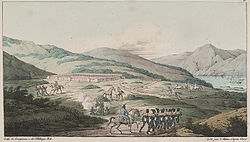
View of Presidio of San Francisco circa 1817
by Louis Choris
.
.
.
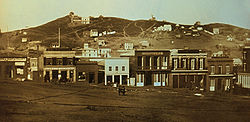
Portsmouth Square, 1851.
|
On July 31, 1846, Yerba Buena doubled in population when
about 240 Mormon pioneers from the East coast arrived on the ship Brooklyn,
led by Sam Brannan. Brannan, also a member of the Church of Jesus Christ
of Latter Day Saints, would later become well known for being the first
publicist of the California Gold Rush of 1849 and the first millionaire
resulting from it.
US Navy Commodore John D. Sloat claimed California for
the United States on July 7, 1846, during the Mexican-American War, and
US Navy Captain John Berrien Montgomery and US Marine Second Lieutenant
Henry Bulls Watson of the USS Portsmouth arrived to claim Yerba Buena two
days later by raising the flag over the town plaza, which is now Portsmouth
Square in honor of the ship. Henry Bulls Watson was placed in command of
the garrison there. In August 1846, Lt. Washington A. Bartlett was named
alcalde of Yerba Buena. On January 30, 1847, Lt. Bartlett's proclamation
changing the name Yerba Buena to San Francisco took effect. The city and
the rest of California officially became American in 1848 by the Treaty
of Guadalupe Hidalgo, which ended the Mexican-American War. California
was admitted to the U.S. as a state on September 9, 1850—the State of California
soon chartered San Francisco and San Francisco County. At the time the
county and city were not coterminous; the county contained modern-day northern
San Mateo County.
Situated at the tip of a windswept peninsula without water
or firewood, San Francisco lacked most of the basic facilities for a 19th-century
settlement. These natural disadvantages forced the town's residents to
bring water, fuel and food to the site. The first of many environmental
transformations was the city's reliance on filled marshlands for real estate.
Much of the present downtown is built over the former Yerba Buena Cove,
granted to the city by military governor Stephen Watts Kearny in 1847.
| 1848 gold rush
The California gold rush starting in 1848 led to a large
boom in population, including considerable immigration. Between January
1848 and December 1849, the population of San Francisco increased from
1,000 to 25,000. The rapid growth continued through the 1850s and under
the influence of the 1859 Comstock Lode silver discovery. This rapid growth
complicated city planning efforts, leaving a legacy of narrow streets that
continues to cause traffic problems today. San Francisco became America's
largest city west of the Mississippi River, until it lost that title to
Los Angeles in 1920.
The population boom included many workers from China who
came to work in the gold mines and later on the Transcontinental Railroad.
The Chinatown district of the city became and is still one of the largest
in the country; today as a result of that legacy, the city as a whole is
roughly one-fifth Chinese, one of the largest concentrations outside of
China. Many businesses founded to service the growing population exist
today, notably Levi Strauss & Co. clothing, Ghirardelli chocolate,
and Wells Fargo bank. Many famous railroad, banking, and mining tycoons
or "robber barons" such as Charles Crocker, Mark Hopkins, Collis P. Huntington,
and Leland Stanford settled in the city in its Nob Hill neighborhood. The
sites of their mansions are now famous and expensive San Francisco hotels
(Mark Hopkins Hotel and the Huntington Hotel).
As in many mining towns, the social climate in early San
Francisco was chaotic. Committees of Vigilance were formed in 1851, and
again in 1856, in response to crime and government corruption. This popular
militia movement lynched 12 people, kidnapped hundreds of Irishmen and
government militia members, and forced several elected officials to resign.
The Committee of Vigilance relinquished power both times after it decided
the city had been "cleaned up." This mob activity later focused on Chinese
immigrants, creating many race riots. These riots culminated in the creation
of the Chinese Exclusion Act in 1882 that aimed |
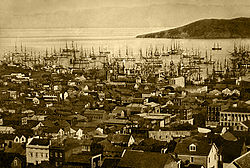
San Francisco harbor in 1850 or 1851.
During this time, the harbor would become
so crowded that ships often had to wait
days before unloading their passengers
and goods.
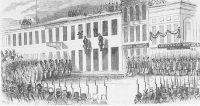
Charles Cora and James Casey are
lynched by the Committee of Vigilance, 1856.
|
to reduce Chinese immigration to the United States by limiting
immigration to males and reducing numbers of immigrants allowed in the
city. The law was not repealed until 1943 with the Magnuson Act.
San Francisco was the county seat of San Francisco County,
one of state's 18 original counties since California's statehood in 1850.
Until 1856, the city limits extended west to Divisadero Street and Castro
Street, and south to 20th Street. In response to the lawlessness and vigilantism
that escalated rapidly between 1855 and 1856, the California government
decided to divide the county. A straight line was then drawn across the
tip of the San Francisco Peninsula just north of San Bruno Mountain. Everything
south of the line became San Mateo County while everything north of the
line became the new consolidated City and County of San Francisco, to date
the only consolidated city-county in California.
In autumn of 1855, a ship bearing refugees from an ongoing
cholera epidemic in the Far East (authorities disagree as to whether this
was the S.S. Sam or the S.S. Carolina but primary documents indicate that
the Caroline was involved in the epidemic of 1850 and the SS Uncle Sam
in the epidemic of 1855) docked in San Francisco. As the city's rapid Gold
Rush area population growth had significantly outstripped the development
of infrastructure, including sanitation, a serious cholera epidemic quickly
broke out. The responsibility for caring for the indigent sick had previously
rested on the state, but faced with the San Francisco cholera epidemic,
the state legislature devolved this responsibility to the counties, setting
the precedent for California's system of county hospitals for the poor
still in effect today. The Sisters of Mercy were contracted to run San
Francisco's first county hospital, the State Marine and County Hospital,
due to their efficiency in handling the cholera epidemic of 1855. By 1857,
the order opened St. Mary's Hospital on Stockton Street, the first Catholic
hospital west of the Rocky Mountains. In 1905, The Sisters of Mercy purchased
a lot at Fulton and Stanyan Streets, the current location of St. Mary's
Medical Center, the oldest continually operating hospital in San Francisco.
Due to the Gold Rush, and despite the Vigilantes, and
the gradual implementation of law and order in San Francisco, its red-light
district at the time became known as the Barbary Coast which became a hotbed
of gambling, prostitution and most notoriously for Shanghaiing. It is now
overlapped by Chinatown, North Beach, Jackson Square, and the Financial
District.
Paris of the West
| It was during the 1860s to the 1880s when San Francisco
began to transform into a major city, starting with massive expansion in
all directions, creating new neighborhoods such as the Western Addition,
the Haight-Ashbury, Eureka Valley, the Mission District, culminating in
the construction of Golden Gate Park in 1887. The City's famous Cable Cars
were built around this time, a unique invention devised by Andrew Smith
Hallidie in order to traverse the City's steep hills while connecting the
new residential developments. San Francisco grew in cultural prominence
at this time as famous writers Mark Twain, Bret Harte, Ambrose Bierce,
Rudyard Kipling, Robert Louis Stevenson, and Oscar Wilde spent time in
the city, while local characters developed such as Emperor Norton.
By the 1890s, much like across the United States, San
Francisco was suffering from machine politics and corruption, and was ripe
for political reform. Adolph Sutro ran for mayor in 1894 under the auspices
of the Populist Party and won handily without campaigning. Unfortunately,
except for the Sutro Baths, Mayor Sutro substantially failed in his efforts
to improve the city.
The next mayor, James D. Phelan elected in 1896, was more
successful, pushing through a new city charter that allowed for the ability
to raise funds through bond issues. He was able to get bonds passed to
construct a new sewer system, seventeen new schools, two parks, a hospital,
and a main library. After leaving office in 1901, Phelan became interested
in remaking San Francisco into a grand and modern Paris of the West.
In 1900, a ship brought with it rats infected with bubonic
plague to initiate the San Francisco plague of 1900–1904; the first plague
epidemic in the continental US. Mistakenly believing that interred corpses
contributed to the transmission of plague, and possibly also motivated
by the opportunity for profitable land speculation, city leaders banned
all burials within the city. Cemeteries moved to the undeveloped area just
south of the city limit, now the town of Colma, California. A fifteen-block
section of Chinatown was quarantined while city leaders squabbled over
the proper course to take, but the outbreak was finally eradicated by 1905.
However, the problem of existing cemeteries and the shortage of land in
the city remained. In 1912 (with fights extending until 1942), all remaining
cemeteries in the city were evicted to Colma, where the dead now outnumber
the living by more than a thousand to one. The above-ground Columbarium
of San Francisco was allowed to remain, as well as the historic cemetery
at Mission Dolores, the grave of Thomas Starr King at the Unitarian Church,
and the San Francisco National Cemetery at the Presidio of San Francisco.
|
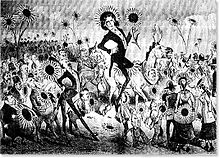
Keller cartoon from the Wasp of
San Francisco depicting Oscar Wilde
n the occasion of his visit there in 1882.
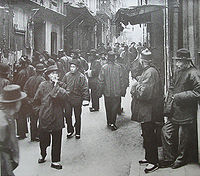
Ross Alley in
San Francisco's Chinatown 1898.
(Photo by Arnold Genthe)
|
| 1906 earthquake and fire
On April 18, 1906, a devastating earthquake resulted from
the rupture of over 270 miles of the San Andreas Fault, from San Juan Bautista
to Eureka, centered immediately offshore of San Francisco. The quake is
estimated by the USGS to have had a magnitude of 7.8 on the Richter scale.
Water mains ruptured throughout San Francisco, and the fires that followed
burned out of control for days, destroying approximately 80% of the city,
including almost all of the downtown core. Many residents were trapped
between the water on three sides and the approaching fire, and a mass evacuation
across the Bay saved thousands. Refugee camps were also set up in Golden
Gate Park, Ocean Beach, and other undeveloped sections of the city. The
official death toll at the time was 478, although it was officially revised
in 2005 to 3,000+. The initial low death toll was concocted by civic, state,
and federal officials who felt that reporting the actual numbers would
hurt rebuilding and redevelopment efforts, as well as city and national
morale.
Reconstruction
Almost immediately after the quake re-planning and reconstruction
plans were hatched to quickly rebuild the city. One of the more famous
and ambitious plans, proposed before the fire, came from famed urban planner,
Daniel Burnham. His bold plan called for Haussmann style avenues, boulevards,
and arterial thoroughfares that radiated across the city, a massive civic
center complex with classical structures, what would have been the largest
urban park in the world, stretching from Twin Peaks to Lake Merced with
a large athenaeum at its peak, and various other proposals. This plan was
dismissed at the time and by critics now, as impractical and unrealistic
to municipal supply and demand. Property owners and the Real Estate industry
were against the idea as well due to the amounts of their land the city
would have to purchase to realize such proposals. While the original street
grid was restored, many of Burnham's proposals eventually saw the light
of day such as a neo-classical civic center complex, wider streets, a preference
of arterial thoroughfares, a subway under Market Street, |
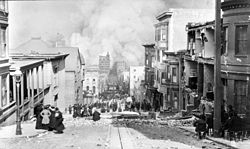
Nob Hill, looking down Sacramento Street,
during the fire that burned down the
city after the Earthquake.
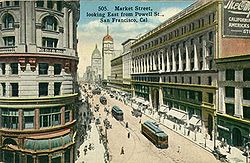
By the time of this postcard circa 1920s,
San Francisco had been fully rebuilt.
|
a more people friendly Fisherman's Wharf, and a monument
to the city on Telegraph Hill, Coit Tower.
In 1907 and 08, the city was rocked by graft investigations
and trials involving bribery of the Board of Supervisors from so-called
public service corporations that put mayor Eugene Schmitz and Abe Ruef
in jail.
"Greater San Francisco" movement of 1912
In 1912, there was a movement to create a Greater San
Francisco in which southern Marin County, the part of Alameda County which
includes Oakland, Piedmont and Berkeley, and northern San Mateo County
from San Bruno northwards would have become outer Boroughs of San Francisco,
with the City and County of San Francisco functioning as Manhattan, based
on the New York City model. East Bay opposition defeated the San Francisco
expansion plan in the California legislature, and later attempts at San
Francisco Bay Area metropolitan area consolidation in 1917, 1923, and 1928
also failed to be implemented.
Panama-Pacific Exposition of 1915
In 1915, the city hosted the Panama-Pacific Exposition,
officially to celebrate the opening of the Panama Canal, but also as a
showcase of the vibrant completely rebuilt city less than a decade after
the Earthquake. After the exposition ended, all of its grand buildings
were
demolished except for the rebuilt Palace of Fine Arts which survives today
in an abbreviated form, while the remainder of the fairgrounds were re-developed
into the Marina District.
1930s-World War II
1934 saw San Francisco become the center of the West Coast
waterfront strike. The strike lasted eighty-three days and saw the deaths
of two workers, but the result led to the unionization of all of the West
Coast ports of the United States.
The San Francisco – Oakland Bay Bridge was opened in 1936
and the Golden Gate Bridge in 1937. The 1939 Golden Gate International
Exposition was held on Treasure Island. It was in this period that the
island of Alcatraz, a former military stockade, began its service as a
federal maximum security prison, housing notorious inmates such as Al Capone,
and Robert Franklin Stroud, The Birdman of Alcatraz.
During World War II, San Francisco was the major mainland
supply point and port of embarkation for the war in the Pacific. It also
saw the largest and oldest enclave of Japanese outside of Japan, Japantown,
completely empty out many of its residents as a result of Executive Order
9066 that forced all Japanese of birth or decent in the United States to
be interned. By 1943 many large sections of the neighborhood remained vacant
due to the forced internment. The void was quickly filled by thousands
of African Americans who had left the South to find wartime industrial
jobs in California as part of the Great Migration. Many African Americans
also settled in the Fillmore District and most notably near the Bayview-Hunters
Point shipyards, working in the dry-docks there. The same docks at Hunters
Point would be used for loading the key fissile components of the first
atomic bomb onto the USS Indianapolis in July 1945 for transfer to Tinian.
The War Memorial Opera House which opened in 1932, was
the site of some significant post World War II history. In 1945, the conference
that formed the United Nations was held there, with the UN Charter being
signed nearby in the Herbst Theatre on June 26. Additionally the Treaty
of San Francisco which formally ended war with Japan and established peaceful
relations, was drafted and signed here six years later in 1951.
Post-World War II
After World War II, many American military personnel who
fell in love with the city when they left for or returning from the Pacific,
settled in the city, prompting the creation of the Sunset District, Visitacion
Valley, and the total build out of San Francisco. During this period, Caltrans
commenced an aggressive freeway construction program in the Bay Area. However,
Caltrans soon encountered strong resistance in San Francisco, for the city's
high population density meant that virtually any right-of-way would displace
a large number of people. Caltrans tried to minimize displacement (and
its land acquisition costs) by building double-decker freeways, but the
crude state of civil engineering at that time resulted in construction
of some embarrassingly ugly freeways which ultimately turned out to be
seismically unsafe. In 1959, the Board of Supervisors voted to halt construction
of any more freeways in the city, an event known as the Freeway Revolt.
Although some minor modifications have been allowed to the ends of existing
freeways, the city's anti-freeway policy has remained in place ever since.
1958 saw the New York Giants move to San Francisco to
become the San Francisco Giants, with their first stadium, Candlestick
Park constructed in 1959.
Urban renewal
In the 1950s San Francisco mayor George Christopher hired
M. Justin Herman to head the redevelopment agency for the city and county.
Justin Herman began an aggressive campaign to tear down so-called blighted
areas of the city that were really working class, non-white neighborhoods.
Enacting eminent domain whenever necessary, he set upon a plan to tear
down huge areas of the city and replace them with modern construction.
Critics accused Herman of racism for what was perceived as attempts to
create segregation and displacement of blacks. Many black residents were
forced to move from their homes near the Fillmore jazz district to newly
constructed projects such as near the naval base at Hunter's Point or even
to other cities such as Oakland. He began leveling entire areas in San
Francisco's Western Addition and Japantown neighborhoods. Herman also completed
the final removal of the produce district below Telegraph Hill, moving
the produce merchants to the Alemany Boulevard site. His planning led to
the creation of Embarcadero Center, the Embarcadero Freeway, Japantown,
the Geary Street superblocks, and eventually Yerba Buena Gardens.
1960-1970s
"Summer of Love" and counterculture movement.
Following World War II, San Francisco became a magnet
for America's counterculture. During the 1950s, City Lights Bookstore in
the North Beach neighborhood was an important publisher of Beat Generation
literature. Some of the story of the evolving arts scene of the 1950s is
told in the article San Francisco Renaissance. During the latter half of
the following decade, the 1960s, San Francisco was the center of hippie
and other alternative culture.
In 1967, thousands of young people entered the Haight-Ashbury
district during what became known as the Summer of Love. The San Francisco
Sound emerged as an influential force in rock music, with such acts as
Jefferson Airplane and the Grateful Dead achieving international prominence.
These groups blurred the boundaries between folk, rock and jazz traditions
and further developed rock's lyrical content.
1980's
During the administration of Mayor Dianne Feinstein (1978–1988),
San Francisco saw a development boom referred to as "Manhattanization."
Many large skyscrapers were built - primarily in the Financial District
- but the boom also included high-rise condominiums in some residential
neighborhoods. An opposition movement gained traction among those who felt
the skyscrapers ruined views and destroyed San Francisco's unique character.
Similar to the freeway revolt in the city decades earlier, a "skyscraper
revolt" forced the city to embed height restrictions in the planning code.
For many years, the limits slowed construction of new skyscrapers. She
had also spearheaded the development and construction of the city's convention
center, the Moscone Center, preserved and renovated the city's Cable Cars,
and attracted the 1984 Democratic National Convention.
During the early 1980s, homeless people began appearing
in large numbers in the city, the result of multiple factors including
the closing of state institutions for the mentally ill, the Reagan administration
drastically cutting Section 8 housing benefits, and social changes which
increased the availability of addictive drugs. Combined with San Francisco's
attractive environment and generous welfare policies the problem soon became
endemic. Mayor Art Agnos (1988–92) was the first to attack the problem,
and not the last; it is a top issue for San Franciscans even today. His
program, Beyond Shelter, became the basis for federal programs and was
recognized by Harvard for Innovations in Local Government. Agnos allowed
the homeless to camp in the Civic Center park after the Loma Prieta earthquake
that made over 1,000 SRO’s uninhabitable, which led to its title of "Camp
Agnos.” His opponent used this to attack Agnos in 1991, an election Agnos
lost. Frank Jordan launched the "MATRIX" program the next year, which aimed
to displace the homeless through aggressive police action. And it did displace
them - to the rest of the city. His successor, Willie Lewis Brown, Jr.,
was able to largely ignore the problem, riding on the strong economy into
a second term. Later, mayor Gavin Newsom created the controversial "Care
Not Cash" program and policy on the homeless, which calls for ending the
city's generous welfare policies towards the homeless and instead placing
them in affordable housing and requiring them to attend city funded drug
rehabilitation and job training programs.
1989 Loma Prieta earthquake
On October 17, 1989, an earthquake measuring 6.9 on the
Richter magnitude scale struck on the San Andreas Fault near Loma Prieta
Peak in the Santa Cruz mountains, approximately 70 miles (113 km) south
of San Francisco, a few minutes before Game 3 of the 1989 World Series
was scheduled to begin at Candlestick Park. The quake severely damaged
many of the city's freeways including the Embarcadero Freeway and the Central
Freeway. Mayor Agnos made the controversial decision to tear down the Embarcadero
Freeway, opening the waterfront but eventually shifting Chinatown voters
away from him and costing him re-election in 1991. The quake also caused
extensive damage in the Marina District and the South of Market neighborhoods.
Despite the significant destruction the earthquake had caused throughout
the greater Bay Area, only 67 died. The World Series resumed a week later
with the loss of the Giants to the Oakland A's.
1990s
The 1990s saw the demolition of the quake damaged Embarcadero
and Central Freeway, restoring the once blighted Hayes Valley and the restoration
of its waterfront promenade, The Embarcadero. In 1994 as part of the Base
Realignment and Closure plan, the former military bases of San Francisco
Naval Shipyard in Bayview-Hunters Point was closed and returned to the
city while the Presidio was turned over to the National Park Service and
since converted into a national park.
In 1996, the city elected its first and to date only African
American mayor, former Speaker of the California State Assembly, Willie
Brown. Brown called for expansions to the San Francisco budget to provide
for new employees and programs. During Brown's tenure, San Francisco’s
budget increased to US$5.2 billion and the city added 4,000 new employees.
His tenure saw the development and construction of the new Mission Bay
neighborhood, and baseball stadium for the Giants, AT&T Park which
was 100% privately financed.
Dot-com boom
During the dot-com boom of the late 1990s, large numbers
of entrepreneurs and computer software professionals moved into the city,
followed by marketing and sales professionals, and changed the social landscape
as once poorer neighborhoods became gentrified. The rising rents forced
many people, families, and businesses to leave. San Francisco has the smallest
share of children of any major U.S. city, with the city's 18 and under
population at just 14.5 percent.
2000s
In 2001, the markets crashed, the boom ended, and many
left San Francisco. South of Market, where many dot-com companies were
located, had been bustling[citation needed] and crowded with few vacancies,
but by 2002 was a virtual wasteland of empty offices and for-rent signs.
Much of the boom was blamed for the city's "fastest shrinking population",
reducing the city's population by 30,000 in just a few years. While the
bust has helped put an ease on the city's apartment rents, the city remains
expensive. By 2003, the city's economy had recovered from the dot-com crash
thanks to a resurgent international tourist industry and the Web 2.0 boom
that saw the creation of many new internet and software start-up companies
in the city, attracting white-collar workers to recent University graduate
young adults from all over the world. Residential demand as well
as rents rose again, and as a result of such demand, city officials relaxed
building height restrictions and zoning codes to construct residential
condominiums in SOMA such as One Rincon Hill, 300 Spear Street, and Millennium
Tower, although the late 2000s recession has indefinitely halted many construction
projects such as Rincon Hill. Part of this development is the reconstruction
of the Transbay Terminal Replacement Project.
2010s
2010 saw the San Francisco Giants win their first World
Series title since moving from New York City. The estimated 1 million people
who attended their victory parade is considered one of the largest in city
history. 2012 saw the Giants win their second title in San Francisco. Celebrations
citywide were marred by rioting which caused millions of dollars in property
damage
In 2011, due to his election as Lieutenant Governor of
California, Gavin Newsom vacated his office early, and passed the role
to city manager Edwin Lee who was subsequently elected the first Chinese
American mayor in any American major city. Mayor Lee has been a strong
proponent of tenant's rights, but also a business-friendly mayor to the
city's burgeoning tech community.
By 2013, San Francisco, with thanks from the Web 2.0 boom,
had fully recovered from the late 2000s recession and is experiencing a
real estate and population boom. Rents in the city had become second to
Manhattan as far as the most expensive in the nation. |